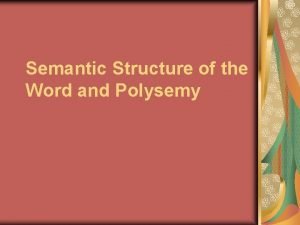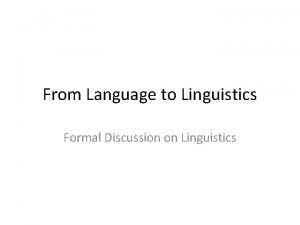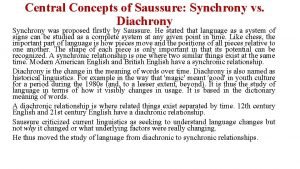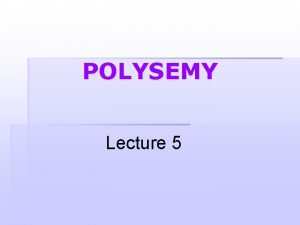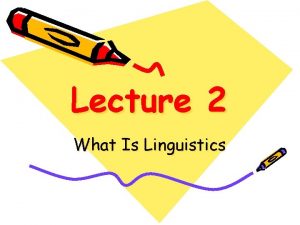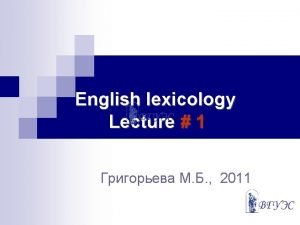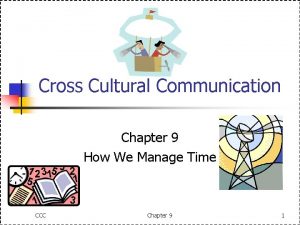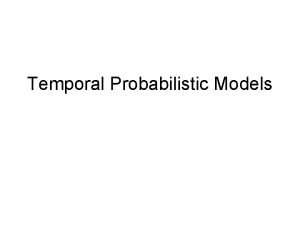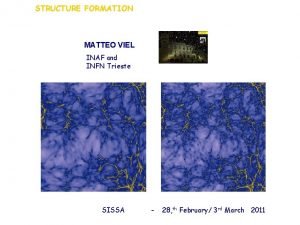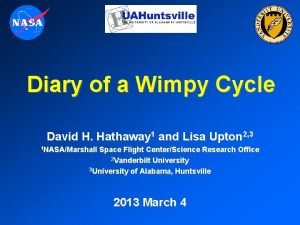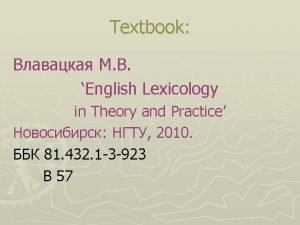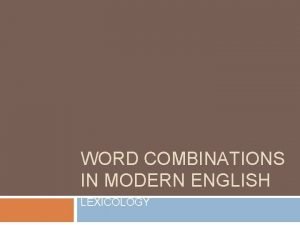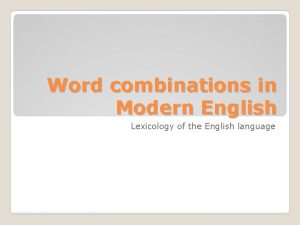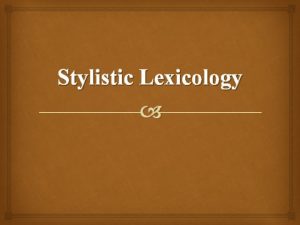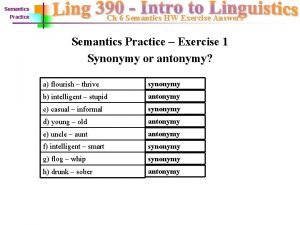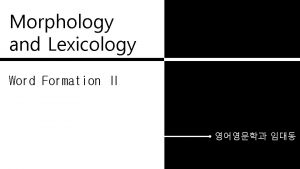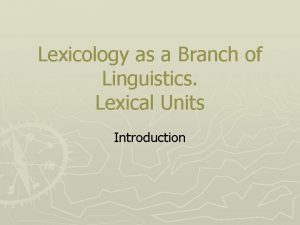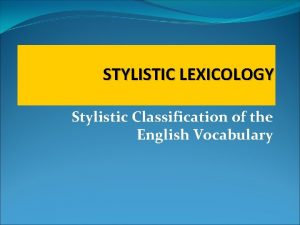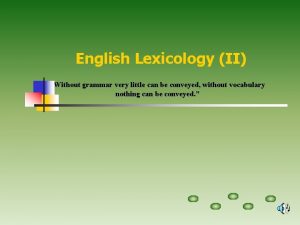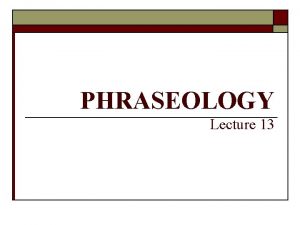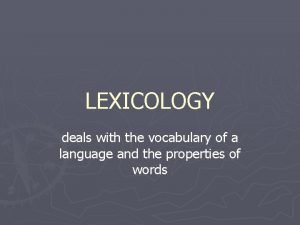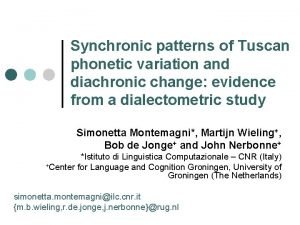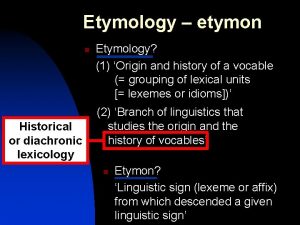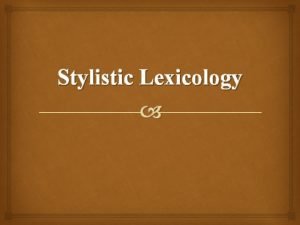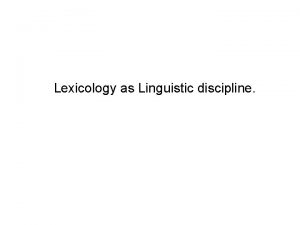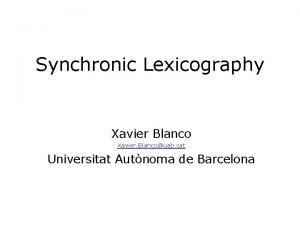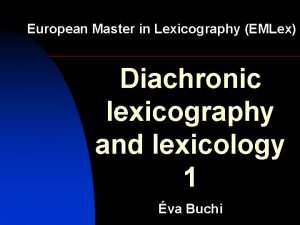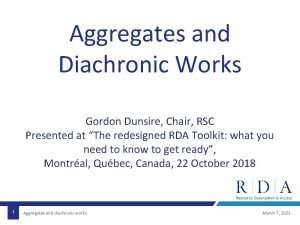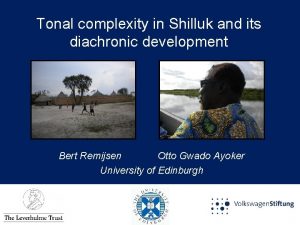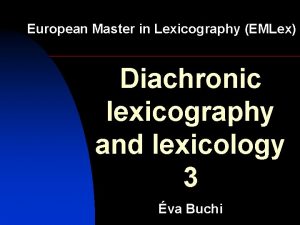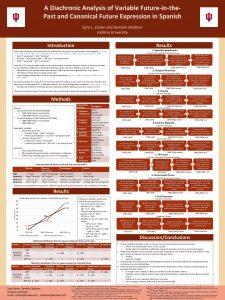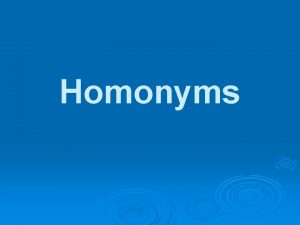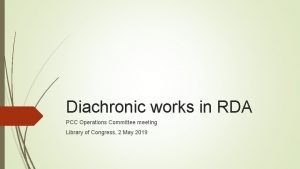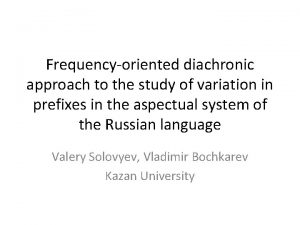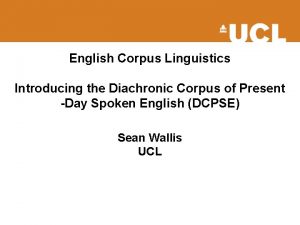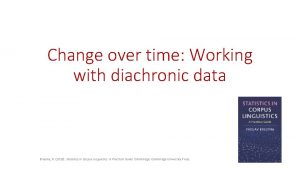Why and how synchronic and diachronic lexicology and



























- Slides: 27

Why and how synchronic and diachronic lexicology and lexicography meet Éva Buchi (ATILF/CNRS & Université de Lorraine) & Carlos Valcárcel Riveiro (Universidade de Vigo) European Master in Lexicography (EMLex) Budapest, May 4 2016 www. atilf. fr/perso/buchi

Analyse et Traitement Informatique de la Langue Française European Master in Lexicography (EMLex) Nancy 2 Stellenbosch Hildesheim Santiago Katowice Braga Erlangen Rome Budapest

Analyse et Traitement Informatique de la Langue Française Degree structure Ø 1 st semester: • in-class learning in the different home universities • e-learning in English and German Ø 2 nd semester: • all students enrol at one of the EMLex-universities • in-class learning in English and German Ø 3 rd semester: • in-class learning in the different home universities • e-learning in English and German • internship at a company or research institute Ø 4 th semester: 3 • Master’s thesis

Analyse et Traitement Informatique de la Langue Française 2 nd semester 2016 in Budapest 1. Metalexicography Zita Hollós (KRE) 2. History of lexicography 3. Learner’s dictionaries 4. Using dictionaries Dóra Pődör (KRE) 5. Specialized lexicography 6. Computational lexicography 7. Dictionaries and translation 8. Lexicography and lexicology 4 9. Dictionary planning Éva Buchi and Carlos Valcárcel Riveiro

Analyse et Traitement Informatique de la Langue Française How etymology relies on synchronic lexicology = diachronic lexicology What constitutes an etymological (and etymographical) unit? 5

Analyse et Traitement Informatique de la Langue Française Metalexicological and metalexicographical topic Theoretical in its essence, but poses practical problems to practitioners of historical lexicology and lexicography ATILF lab (Nancy, France) Dictionnaire Étymologique Roman (DÉRom) European Master in Lexicography 6

Analyse et Traitement Informatique de la Langue Française Etymological dictionary ‘DICTIONARY in which words are traced back to their earliest appropriate forms and meanings’ (Hartmann & James, Dictionary of lexicography, 1998) Lacks technical rigour ambiguous Threefold terminology established within theoretical framework of Meaning-text theory (Mel’čuk 2012: 1: 21 -44) 7

Analyse et Traitement Informatique de la Langue Française Meaning-text theory (MTT) Theoretical framework first put forward by Aleksandr Žolkovskij and Igor Mel'čuk (Moscow 1965) for the construction of models of natural language Provides an elaborate basis for linguistic description and, due to its formal character, lends itself particularly well to computer applications, including lexicography Explanatory-combinatorial dictionaries (ECD) 8

Analyse et Traitement Informatique de la Langue Française MTT provides a threefold terminology Ø Wordform ‘segmental linguistic sign that is autonomous and minimal, i. e. , that is not made up of other wordforms’ table 1 ~ tables 1 SINGULAR PLURAL Ø Lexeme ‘set of wordforms, and phrases, that are all inflectional variants’ TABLE 1 Ø Vocable ‘set of lexical units –lexemes or idioms– whose signifiers are identical, whose signifieds display a significant intersection, and whose TABLE syntactics are sufficiently similar’ 9 TABLE 2 ‘arrangement of data’ TABLE 3 ‘surface of a stone’

Analyse et Traitement Informatique de la Langue Française Schematic representation Vocable TABLE Lexeme TABLE 1 table 1 ‘article of furniture consisting of a flat top and legs’SINGULAR Lexeme TABLE 2 Lexeme TABLE 3 table 2 ‘arrangement of data in rows and colums’SINGULAR table 3 ‘upper flat surface of a cut precious stone’SINGULAR Wordforms tables 1 ‘articles of furniture consisting of a flat top and legs’PLURAL 10 tables 2 ‘arrangements of data in rows and colums’PLURAL tables 3 ‘upper flat surfaces of a cut precious stone’PLURAL

Analyse et Traitement Informatique de la Langue Française Etymological dictionaries Wordforms? Lexemes? Vocables? ‘DICTIONARY in which words are traced back to their earliest appropriate forms and meanings’ (Hartmann & James, Dictionary of lexicography, 1998) No indication in theoretical work 11 Current practice in etymological dictionaries?

Analyse et Traitement Informatique de la Langue Française The problem only presents itself with polysemous vocables Example: Spanish ESCAPARATE m. n. ESCAPARATE 1 m. n. ‘glass-door cabinet used for displaying delicate things’ ESCAPARATE 2 m. n. ‘shop window used for displaying samples of what is sold in the shop’ 12

Analyse et Traitement Informatique de la Langue Française Corominas, Breve dicc. etimológico de la lengua castellana, 19733 13 Borrowing from Old Dutch schaprade n. ‘closet (in particular kitchen cupboard)’

Analyse et Traitement Informatique de la Langue Française Corominas’s approach is in accordance with Untermann’s “For me, etymology is defined as: establishing and describing the process which produces a new sequence of phonemes and assigns a meaning to it, using given vocabulary and given grammatical means, in order to meet a requirement which emerges” (Krisch 2010: 317, quoting Untermann 1975: 105) Derivatives and compounds merit an etymology Semantic evolutions do not This choice in favour of the vocable is quite common 14 Counterexamples?

Analyse et Traitement Informatique de la Langue Française Kluge, Etymologisches Wörterbuch der deutschen Sprache, 200224 1) ‘Cue’; 2) ‘headword’; 3) ‘keyword’; 4) ‘hurtful remark’ 4) Homonyms! Vocable! 15

Analyse et Traitement Informatique de la Langue Française TLF (Trésor de la langue française, ATILF 1971 -1994) s. v. agio AGIO 1 ‘excess value of one currency over another’ AGIO 2 ‘bank fees (interest, commission, exchange)’ AGIO 3 ‘dishonest speculation (stock exchange)’ Etymology: “Empr[unt] à l’ital[ien] aggio” Vocable! “Borrowing from Italian aggio” 16

Analyse et Traitement Informatique de la Langue Française Etymology of AGIO revised in the context of TLF-Étym = Steinfeld, Nadine (dir. ) (2005–): Trésor de la Langue Française Étymologique (TLF-Étym). Nancy: ATILF: http: //www. atilf. fr/tlf-etym Selective revision of the etymologies contained in the TLFi (Trésor de la Langue Française informatisé) Entry agio compiled by Franz Rainer, professor at Vienna University of Economics and Business 17

Analyse et Traitement Informatique de la Langue Française First attestations AGIO 1 ‘excess value of one currency over another’ (1679) AGIO 2 ‘bank fees (interest, commission, exchange)’ (1723) AGIO 3 ‘dishonest speculation (stock exchange)’ (1727) 18

Analyse et Traitement Informatique de la Langue Française Italian AGGIO Cortelazzo/Zolli: Dizionario etimologico della lingua italiana (19992): AGGIO 1 ‘excess value of one currency over another’ (1498) AGIO 1 [AGGIO 2 ‘discount on the amount of a tax granted to a state employee’ (1892)] 19 ø AGGIO ‘bank fees’ (Italian SPESE DI COMMISSIONE) AGIO 2 ø AGGIO ‘dishonest speculation’ (Italian SPECULAZIONE DISONESTA) AGIO 3

Analyse et Traitement Informatique de la Langue Française Rainer 2011 in TLF-Étym Three etymologies! AGIO 1 ‘excess value of one currency over another’ 1679 Borrowing from Italian AGGIO 1 ‘excess value of one currency over another’ 1498 AGIO 2 ‘bank fees (interest, commission, exchange)’ 1723 Internal creation: semantic evolution from French AGIO 1 (common denominator: ‘commission’) AGIO 3 ‘dishonest speculation (stock exchange)’ 1727 Internal creation: semantic evolution from French AGIO 2 (common denominator: ‘profit’) 20

Analyse et Traitement Informatique de la Langue Française AGIO 3 coined in the aftermath of the Law affair James Law (1671 -1729) Scottish economist, Controller General of Finances of France Became a millionaire by issuing huge amounts of share certificates of his Mississipi Company to the French These shares were ultimately rendered worthless, and initially inflated speculation about their worth led to a chaotic economic collapse in France in the 1720 Coining of AGIO 3 ‘dishonest speculation’ strongly linked to a French economic context 21

Analyse et Traitement Informatique de la Langue Française What are etymological units made of: vocables or lexemes? Dictionaries are made up of vocables like Spanish ESCAPARATE, German STICHWORT 1 and STICHWORT 2, and French AGIO But French AGIO 3 ‘dishonest speculation’ cannot be considered an Italian borrowing Such lexemes deserve to be individually etymologized (as internal creations) 22

Analyse et Traitement Informatique de la Langue Française Etymological dictionary Lexemes? Vocables? ‘DICTIONARY in which words are traced back to their earliest appropriate forms and meanings’ (Hartmann & James, Dictionary of lexicography, 1998) 23

Analyse et Traitement Informatique de la Langue Française To conclude I advocate a contrario that individual lexemes, not whole vocables, are best hypostatized as etymological (and etymographical) units This seems quite obvious: etymologies which put the different lexemes of a vocable to the centre of their attention are better etymologies Then why did the discipline of etymology have to wait for 2016 for this finding to be put forward? 24

Analyse et Traitement Informatique de la Langue Française The answer lies in the terminology we use Ultimately, in our conceptualization of the units which constitue the lexicon of a language If AGIO 3 ‘dishonest speculation’ = “meaning” of the “word” AGIO, there is no need for etymologizing it Only “words” = linguistic signs = sets of signifiers, signifieds, and syntactic properties may and should be etymologized If AGIO 3 ‘dishonest speculation’ = lexeme = set of signifier, signified, and syntactic properties 25 Then the stage is set for the lexeme becoming the etymological (and etymographical) unit

Analyse et Traitement Informatique de la Langue Française Better conceptualization leads to better etymologies Word table 26 Vocable TABLE Meaning ‘article of furniture consisting of a flat top and legs’ Lexeme TABLE 1 n. ‘article of furniture consisting of a flat top and legs’ Meaning ‘arrangement of data in rows and columns’ Lexeme TABLE 2 n. ‘arrangement of data in rows and columns’ Meaning ‘upper flat surface of a cut precious stone’ Lexeme TABLE 3 n. ‘upper flat surface of a cut precious stone’

Analyse et Traitement Informatique de la Langue Française Why is this important? The 64 arts of Kamasutra 1. Singing 2. Playing instruments 3. Dancing 4. Painting […] 54. Etymology 55. Lexicography 27
 Semantic structure of a word
Semantic structure of a word How does language work
How does language work Special lexicology
Special lexicology Synchrony and diachrony examples
Synchrony and diachrony examples Synchronic and diachronic approaches to polysemy
Synchronic and diachronic approaches to polysemy What is linguistic
What is linguistic Descriptive lexicology
Descriptive lexicology Diachronic vs synchronic bible
Diachronic vs synchronic bible Hey bye bye
Hey bye bye Synchronic vs sequential
Synchronic vs sequential Synchronic
Synchronic Synchronic
Synchronic Synchronic
Synchronic Synchronic
Synchronic Synchronic
Synchronic English lexicology theory and practice
English lexicology theory and practice Connotative meaning of mother
Connotative meaning of mother Free word combinations
Free word combinations Types of word combinations
Types of word combinations Stylistic synonyms lexicology
Stylistic synonyms lexicology Semantic answer key
Semantic answer key Partial conversion lexicology
Partial conversion lexicology Lexicology as a branch of linguistics
Lexicology as a branch of linguistics Introduction to lexicology
Introduction to lexicology Barbarisms and foreignisms
Barbarisms and foreignisms Shortening in lexicology
Shortening in lexicology Types of transference of phraseological units
Types of transference of phraseological units Coinage lexicology
Coinage lexicology
